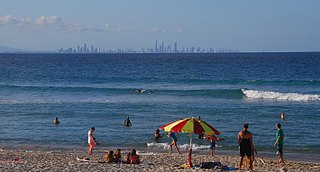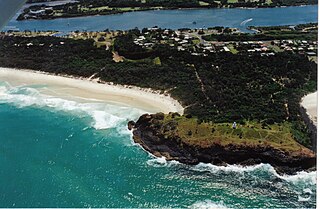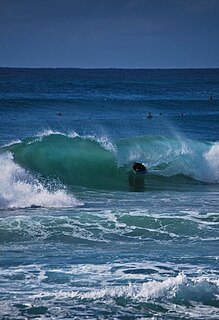
The Gold Coast is a coastal city in the state of Queensland, Australia, approximately 66 kilometres (41 mi) south-southeast of the centre of the state capital Brisbane and immediately north of the border with New South Wales. The area was previously occupied prior to European settlement by the Yugambeh language people. The demonym for the Gold Coast is Gold Coaster. With an estimated population of 679,127 in June 2018, the Gold Coast is the sixth-largest city in Australia, Australia's largest non-capital city, and Queensland's second-largest city.

The Tweed River is a river situated in the Northern Rivers district of New South Wales, Australia. From the middle reaches of its course, the state boundary between New South Wales and Queensland is located approximately 10 kilometres (6.2 mi) north.

Tweed Heads is a town in New South Wales. It is located on the Tweed River in north-eastern New South Wales, Australia, in Tweed Shire, next to the border with Queensland and adjacent to its "twin town" of Coolangatta, which is a suburb of the Gold Coast. It is often referred to as a town where people can change time zones – even celebrate New Year twice within an hour – simply by crossing the street, due to its proximity to the Queensland border, and the fact that New South Wales observes daylight saving whereas Queensland does not.

Coolangatta is a coastal suburb in the City of Gold Coast, Queensland, Australia. It is the Gold Coast's southernmost suburb and it borders New South Wales. In the 2016 census, Coolangatta had a population of 5,948 people.

Coogee is a beachside suburb of local government area City of Randwick 8 kilometres south-east of the Sydney central business district, in the state of New South Wales, Australia. It is typically associated as being part of the Eastern Suburbs region.

Kirra is a beach-side neighbourhood within the suburb of Coolangatta in the City of Gold Coast, Queensland, Australia.

Greenmount Beach is a beach located in Coolangatta on Queensland's Gold Coast in Australia.

Rainbow Bay is a bay, beach and locality at the southern end of Coolangatta within the City of Gold Coast, Queensland, Australia.

Fingal Head is a village on the Tasman Sea coast in the far northeast of New South Wales, Australia, about 5 km south of the New South Wales and Queensland border. The village is often just called Fingal. The headland and the small off-shore Island were first sighted by James Cook about 17:00 on 16 May 1770. At the time of the 2016 census, Fingal Head had a population of 592 people.
Michael "MP" Peterson was a professional Australian surfer. He was considered one of the best surfers in Australia during the early to mid-1970s and was recognised for his deep tube riding skill, especially at Kirra on the Gold Coast, Australia. Peterson was the Australian champion in the years 1972 and 1974, and won many other major surfing competitions. Peterson was eventually diagnosed with schizophrenia and became publicly known for using illicit drugs.

Bilinga is a southern coastal suburb in the City of Gold Coast, Queensland, Australia. In the 2016 census, Bilinga had a population of 1,804 people. It is on the border with New South Wales.

Tugun is a beach-side coastal suburb of the City of Gold Coast, Queensland, Australia. It borders New South Wales. At the 2016 census, Tugun had a population of 6,588. Locals refer to the suburb as Tugz.
The Gold Coast Shoreline Management Plan (GCSMP) is an ICZM plan to manage the coastal resources of City of Gold Coast. The EPA encourages the City Council's to produce shoreline management plans for coastlines and tidal waterways within the local authority area.
A surf break is a permanent obstruction such as a coral reef, rock, shoal, or headland that causes a wave to break, forming a barreling wave or other wave that can be surfed, before it eventually collapses. The topography of the seabed determines the shape of the wave and type of break. Since shoals can change size and location, affecting the break, it takes commitment and skill to find good breaks. Some surf breaks are quite dangerous, since the surfer can collide with a reef or rocks below the water.

Wayne "Rabbit" Bartholomew is an Australian world champion surfer, surf sports innovator, community advocate and politician. Bartholomew is the former CEO and President of the Association of Surfing Professionals and the creator of the Dream Tour format of professional competition surfing.

Duranbah Beach, officially known as Flagstaff Beach, is the northernmost beach in New South Wales. Located in the Tweed Shire, Duranbah Beach is situated between the mouth of the Tweed River and the rocky headland Point Danger which also marks the Queensland-New South Wales border. The beach is 350 meters in length with vegetated dunes running along 200 metres. The southern end of the beach features BBQs, sheltered picnic areas including a block of toilets and shower just behind it.
Australian Boardriders Battle is an annual event held by Surfing Australia. Since 2017 the national competition finals have been hosted at Newcastle, New South Wales in February each year. Fox Sports also airs the Australian Boardriders Battle live. The national finals of the first three series were held at Cronulla Beach in Sydney on the Australia Day weekend in late January.
Ocean pools are an important feature of the Australian coastline particularly in New South Wales. Ocean pools or ocean baths are defined as public seawater pools sited on a rocky surf coast, so that waves can wash into the pool. The width, length and depth of ocean pools varies and often depends on their location on the coastline. Australia also has many harbour pools and these are usually netted or fenced and located in harbours or river mouths but not regarded as ocean pools.

Campbell Hill is a mountain located in Piggabeen, New South Wales (NSW), Australia. It is located in the region of the Tweed Shire in the state of New South Wales, in the eastern part of the country, 900 kilometres (560 mi) north of the capital, Canberra, approximately 107 kilometres (66 mi) from Brisbane and 24 kilometres (15 mi) from Surfers Paradise. Campbell Hill is approximately 123 metres (404 ft) above sea level. Piggabeen is situated in the hinterland approximately 5 km behind the Gold Coast Highway and the Gold Coast International and Domestic Airport. Piggabeen and its valley adjoins Currumbin Valley in Queensland.
The Kombumerri clan are one of nine distinct named clan estate groups of the Yugambeh people and the name refers to the Indigenous people of the Nerang area on the Gold Coast, Queensland. Australia


















